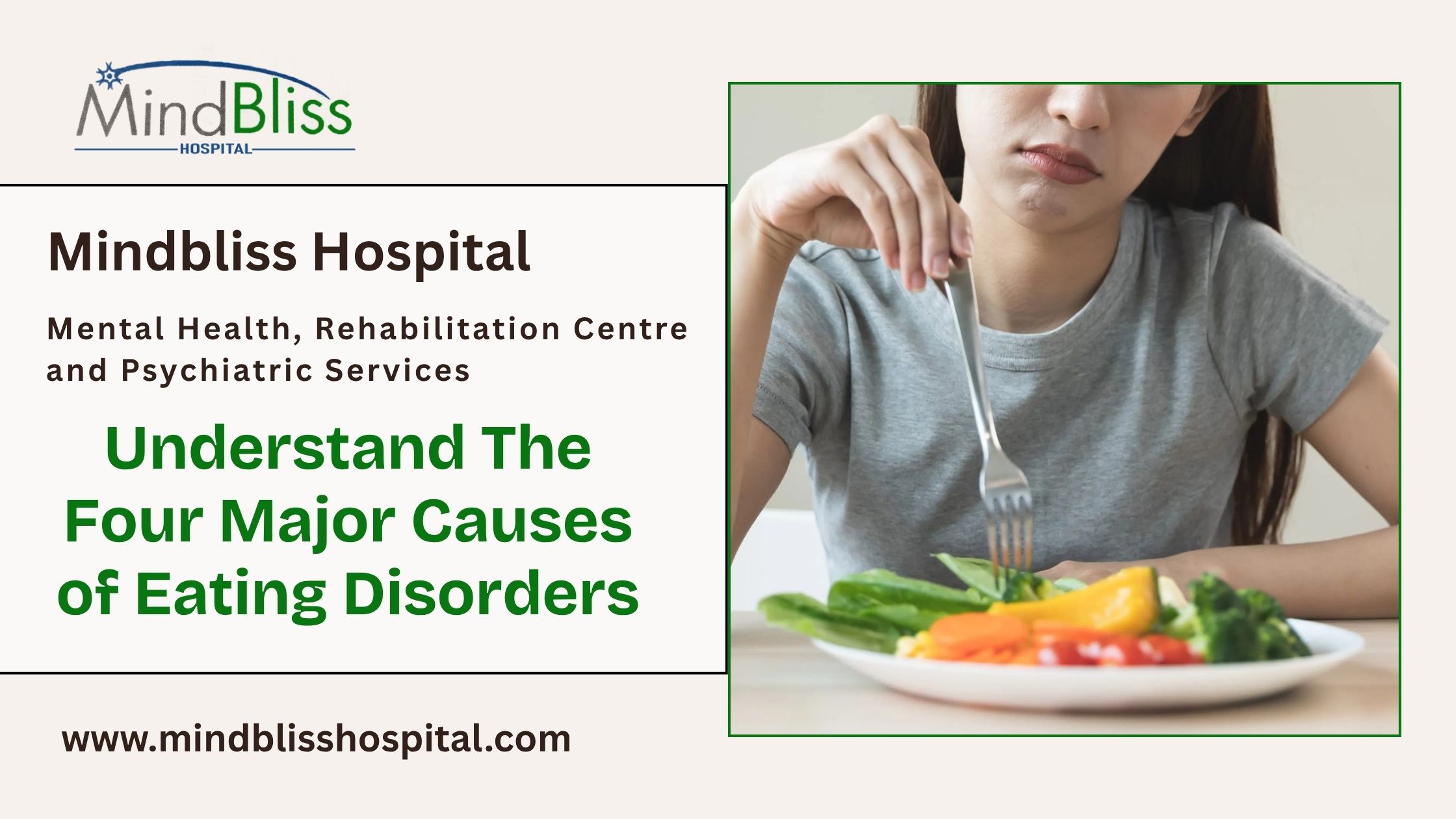
Understand The Four Major Causes of Eating Disorders
Causes of Eating Disorders: Best Guide
Eating disorders represent some of the most serious and complex mental health conditions encountered today. While they frequently centre around unhealthy relationships with food, body image, and weight control, the roots of these disorders are far deeper and more multifaceted than popular culture often lets on. At Mindbliss Hospital, we believe that understanding the underlying causes is a crucial first step toward compassionate care and effective recovery.
In this article, we explore four major categories of causes of eating disorders. These categories help us frame the wide range of biological, psychological, social and environmental influences that intersect to create vulnerability. Although these causes overlap and vary from person to person, the framework supports understanding, prevention and early intervention.
1. Biological & Genetic Vulnerabilities
When we talk about biological causes of eating disorders, we refer to inherited traits, genetic predispositions, neurochemical alterations and physiological responses which create an underlying vulnerability. They don’t “cause” an eating disorder in isolation, but they set the stage for one. Research confirms that eating disorders are “caused by a complex interaction of factors” including biological elements.
Key mechanisms
- Genetic predisposition: Family and twin studies consistently show that if a first-degree relative has an eating disorder, the risk for another family member is significantly higher.
- Neurobiology and neurotransmitters: Brain chemicals such as serotonin and dopamine, which regulate mood, appetite and reward responses, appear altered in many individuals with eating disorders.
- Metabolic or physiological stress responses: Periods of starvation or extreme dieting can themselves trigger brain changes that perpetuate disordered eating behaviours.
- Early development and epigenetic factors: Some research suggests that early life experiences and even epigenetic changes (how genes are expressed) can influence susceptibility.
Why this matters
Because biological vulnerabilities are not visible or easily changed, they often create a sense of helplessness. However, recognising these vulnerabilities helps both clinicians and individuals understand that eating disorders are not simply about willpower or lifestyle choices—they are serious medical-psychiatric conditions. At Mindbliss Hospital, acknowledging this foundation ensures that treatment addresses the body’s biology as well as the mind.
Practical takeaway
- Genetic risk means early monitoring is beneficial (for example, in families with known history).
- Addressing mood disorders, anxiety or compulsive traits early can reduce risk.
- Medical and nutritional supervision is vital once restriction or binge-purge behaviours start, because the body and brain are already being affected, not just the behaviour.
2. Psychological Factors
Psychological causes refer to those individual-level internal processes: thoughts, feelings, personality traits and mental health challenges that influence eating, body image and coping styles. According to research, risk factors such as perfectionism, emotional dysregulation and low self-esteem are strongly linked with eating disorders.
Common psychological influences
- Perfectionism and high achievement orientation: Individuals who hold themselves to very strict standards often direct that drive toward controlling food and body shape.
- Low self-esteem and body dissatisfaction: A persistent negative sense of worth tied to appearance, weight or shape can fuel unhealthy behaviours.
- Emotional dysregulation / coping deficits: When a person struggles to manage negative emotions (anxiety, sadness, shame), they may resort to eating behaviours (over-eating, restricting) as a way to regulate.
- Trauma, anxiety, depression and comorbid mental health conditions: Many with eating disorders also have a history of trauma (emotional, physical, sexual) or other psychiatric diagnoses.
Why this matters
Psychological factors highlight the “why” behind disordered eating: why the individual may feel compelled to control or binge, why food becomes a coping mechanism, why body shape becomes a battleground. At Mindbliss Hospital, therapy and counselling target these underlying psychological patterns rather than simply focusing on “eating right”.
Practical takeaway
- Therapeutic approaches (such as cognitive-behavioural therapy, dialectical behaviour therapy) can address maladaptive thinking and emotion regulation.
- Early identification of perfectionistic, rigid or anxiety-prone behaviours in adolescents can allow proactive support.
- Integrating mental health screening with nutritional support is critical in treatment programmes.
3. Social, Cultural & Environmental Influences
While biology and individual psychology shape a person’s vulnerability, social and cultural environments shape the triggers, reinforcement and maintenance of eating disorders. These influences include societal ideals of thinness, media messaging, peer pressure, family dynamics, dieting culture and more. Research shows that these are major contributors to risk.
Key social and cultural mechanisms
- Societal standards of beauty and thinness: Media and cultural messaging often elevate the “thin ideal”, promoting dissatisfaction with more typical or healthy body sizes.
- Weight stigma, teasing or bullying: Being teased about one’s weight or shape—particularly in adolescence can raise the risk of disordered eating behaviours.
- Diet culture and extreme weight-control practices: Frequent dieting, especially from a young age, or participation in sports or environments emphasising leanness, can precipitate disordered eating.
- Family and peer influences: Family attitudes to food, weight, exercise, and peer group norms can all set the stage for disordered eating patterns.
Why this matters
Social and cultural factors are often overlooked because they feel external, but in many cases they provide the trigger or “final push” from vulnerability to disorder. At Mindbliss Hospital, acknowledging the societal and environmental context means that treatment also involves psycho-education, family involvement, social support and changing the immediate environment where possible.
Practical takeaway
- Schools, workplaces and communities should foster healthy body image norms, challenge weight stigma, and reduce emphasis on extreme dieting.
- Families should encourage regular meals, model healthy attitudes to food and body image, and be alert to peer- or media-driven pressures on adolescents.
- Early intervention programmes should include media literacy, recognition of harmful dieting behaviours, and promotion of diverse body ideals.
4. Life Transitions, Stress & Triggering Events
Finally, many eating disorders are precipitated or exacerbated by specific life changes or stressful events. Though this category overlaps with the earlier three, it’s useful to identify as a distinct cause because it points to timing and context: when someone who is already vulnerable faces a major disruption and the eating disorder is initiated or worsened.
Common triggering scenarios
- Major life changes or transitions: Moving to a new school or college, changing jobs, entering competitive sports, or migrating can destabilize routines and amplify vulnerability.
- Traumatic experiences or losses: Physical or sexual abuse, bullying, death of a loved one, or other significant trauma can trigger disordered eating as a way of coping or regaining control.
- Physical illness or weight-related change: Significant weight fluctuations, medical conditions or injuries can create a focus on body and food.
- Dieting and weight control efforts: Sometimes starting a diet—even for seemingly healthy reasons—can act as the gateway into restriction, bingeing or purging cycles.
Why this matters
Recognising triggering events helps in two key ways: prevention and early detection. At Mindbliss Hospital, we pay attention to patient’s histories not just of food behaviours, but of stressful events and transitions. Doing so helps us tailor support and intervene earlier.
Practical takeaway
- Healthcare providers, counsellors and caretakers should ask about recent life stressors when assessing someone at risk of an eating disorder.
- Supporting healthy coping mechanisms during times of change (e.g., adolescence, training in sport, dieting) can reduce risk.
- Monitoring dieting behaviour carefully, especially for individuals with existing risk factors, is crucial.
Prevention & Early Warning Strategies
Given the four cause-categories, prevention efforts can be more targeted. Below are strategies aligned with each cause category:
- Biological/Genetic: Awareness of family history; early screening for mood disorders; monitoring eating and exercise behaviours in at-risk children/adolescents.
- Psychological: Building emotional resilience, teaching healthy coping strategies, promoting a balanced self-image, identifying perfectionist or rigid cognitive styles.
- Social/Cultural: Encouraging media literacy, limiting exposure to harmful dieting culture, reducing weight-based teasing and stigma in schools/home, fostering acceptance of varied body types.
- Triggers/Transitions: Providing support during major life changes; cautioning against extreme dieting or rapid weight control; ensuring psychological support when significant stress/trama occurs.
By combining prevention across these domains, we stand a better chance at reducing the incidence and severity of eating disorders.
Conclusion
Understanding the four major causes of eating disorders — biological, psychological, social, and environmental triggers — allows us to see these conditions not as choices or habits, but as serious, multifaceted mental health disorders. Each factor plays a unique role in shaping how an eating disorder begins, develops, and affects an individual’s life.
Biological predispositions may create vulnerability, psychological struggles often fuel the disorder, social and cultural pressures reinforce it, and stressful life transitions can trigger or worsen it. Recognizing these interconnected causes helps families, friends, and healthcare professionals intervene early and with compassion.
At Mindbliss Hospital, we emphasize a holistic approach to treatment that addresses every aspect of an individual’s well-being — mind, body, and environment. Our team of psychiatrists, psychologists, and dietitians work together to help patients rebuild a healthy relationship with food, restore self-worth, and regain control of their lives.
Eating disorders are treatable, and recovery is possible with the right care, understanding, and support. If you or someone you know is struggling, remember that reaching out for professional help is the first step toward healing — because every person deserves a life free from the grip of eating disorders.










